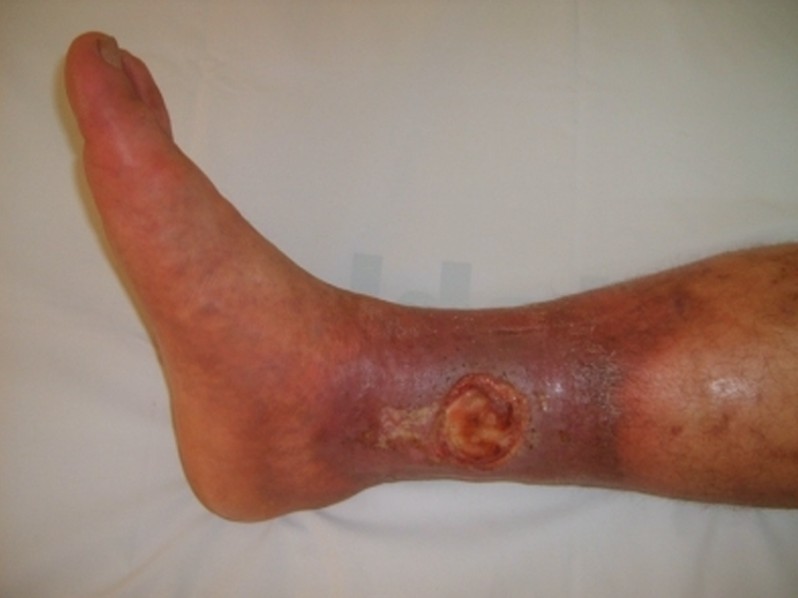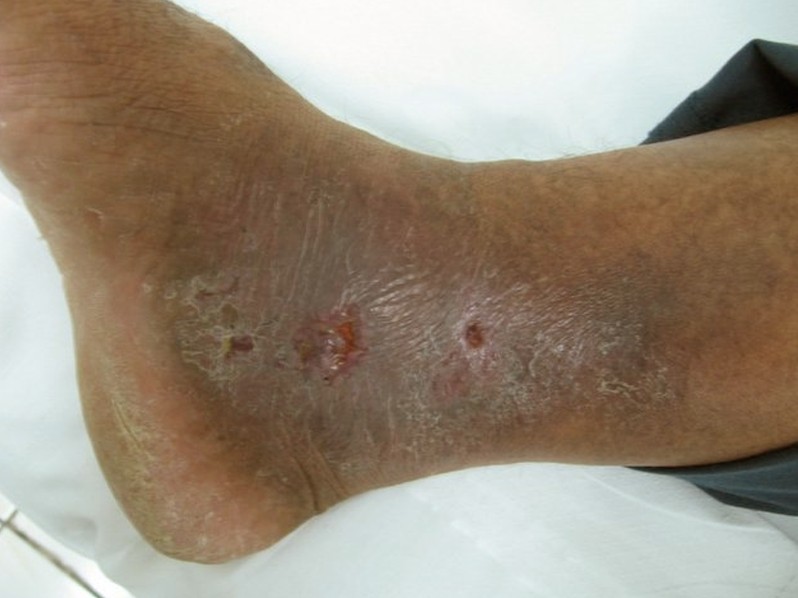Stasis Ulcer
What is Stasis Ulcer?
Stasis ulcer is a skin condition characterized by the ulceration of the skin that is deemed to result from venous insufficiency due to a dysfunction in the venous valve.
Stasis ulcer is also known as venous ulcer or varicose ulcer. Stasis ulcer is the most common ulcer in the lower extremities. It is a chronic skin condition that is more common in women and older adults and is also common among obese individuals. Stasis ulcer is open and shallow ulcer that usually takes 4 weeks to 6 weeks before it can heal.
Stasis ulcer occurs when there is the presence of valve incompetency in the veins of the lower leg. The valve incompetency causes the blood to leak into the superficial veins during contraction of the muscle of the calf and thus preventing the blood from flowing upward.
Older people, women and obese individuals are at high risk for developing a stasis ulcer. The disease is known to occur all over the world regardless of racial group. It usually takes a long time for stasis ulcer to heal and is rather costly while potential for recurrence is highly possible. Proper care and prevention of recurrence is necessary to avoid further complications such as gangrene which can cause irreversible tissue damage.
Stasis Ulcer Symptoms
Stasis ulcer often occurs in bony prominence such as in the medial distal leg and in the ankle. The onset can be painful although some patient experiences no pain. The ulcer in the skin is unsightly and discomfort is common that it can affect the quality of life. The pain is particularly felt when assuming a standing position or when standing for a prolonged period of time. Elevating the affected is beneficial in relieving the pain and in reducing the swelling.
Stasis ulcer is characterized by large and shallow skin ulcer in the medial distal leg or in the ankle. The incidence may also be associated with signs and symptoms of venous hypertension such as the onset of venous flare and varicose veins. The wound is sunken and shaped asymmetrically and the borders are well defined. The skin surrounding the ulcer is firm and hard which makes the affected feel hard causing a heavy feeling in the leg.
The skin of the affected area has a reddish color and is scaly. An enlarged and swollen vein may also be seen. Pus or yellowish-whitish exudates may also happen signifying an onset of infection. The skin ulcer may also have a foul smelling discharge which can be disturbing.
Onset of high fever may also be experienced which signifies infection. The pain is also worsening and the ulcer can be seen with a greenish discharge that emits a foul smell.
The presence of signs and symptoms of stasis ulcer should prompt the affected individual to seek medical consultation. It is also advisable to seek a specialist when infection is present. Stasis ulcer does not resolve on its own that medical treatment is necessary to address the condition and to prevent further medical complications.
Causes
The exact cause of stasis ulcer is still unclear. The etiology is thought to be the result of increased pressure in the veins of the lower leg subsequently leading to blood leaking out of the skin. The blood pooling on the skin surface causes the skin to break, leading to ulceration. The increased pressure of blood in the lower leg is the consequence of an incompetent valve. When valve incompetency occurs, the deoxygenated blood is prevented from flowing back to the heart and is rather brought back to the valve that is damaged where it will later collect in the veins of the lower leg.
Stasis ulcer involves the vein and the valve. The vein is responsible for carrying deoxygenated blood to the heart then to the lungs. The valve on the other hand is responsible in preventing the blood from flowing backward. The blood flow along the veins is helped by the muscle contraction.
The lower leg is composed of a calf which is the pumping function of the leg to help the blood from flowing along the veins. Both the venous hypertension and valve incompetency are the primary mechanism in the formation of stasis ulcer.
Although there is no exact cause that can be pinpointed in stasis ulcer, several factors are considered that increases the risk for developing the disease.
The factors considered at the onset of stasis ulcer include the following:
Age
Age is considered to increase the chances for stasis ulcer. Older people are predisposed to the incidence which could be related to poor peripheral circulation as part of the normal aging process. The risk for stasis ulcer also increases as one advance in age as well. Age advancement generally makes it harder for an individual to be moving about.
Obesity
Obesity greatly increases the chances for stasis ulcer. This could be related to the increased risk for pressure buildup in the vein. The pressure buildup could be associated with the heavy weight or the weight bearing of an obese individual.
Varicose vein
Varicose vein can damage the valve that prevents the blood from flowing backward into the vein. This increases the risk for stasis ulcer when the blood collects in the vein later causing damages in the skin.
Cigarette smoking
Cigarette smoking can cause the blood vessels to constrict thereby interrupting the blood flow and in turn increases the pressure and damages the vein.
Treatment for Stasis Ulcer
The primary goal of treatment in stasis ulcer is to promote wound healing while reducing edema and preventing recurrence.
Various treatment methods are available for stasis ulcer and this includes the following:
- Compression bandaging
- Leg elevation
- Debridement and cleaning of the ulcer
- Wound dressing
- Antibiotics
- Aspirin
- Topical steroids
- Pentoxyfilline
- Surgical procedures such as skin grafting
Stasis Ulcer Pictures
Collection of pics, images and pictures of Stasis Ulcer…
Stasis Ulcer Prevention
Stasis ulcer often recurs after it has resolved. To prevent recurrence, wearing of compression stocking is recommended. It is recommended to be worn during the daytime over the period of five years from the time the ulcer has healed.
A diet change is necessary for those who have heavy weight. Heavy weight individuals should also consider losing weight.
Cigarette smoking is considered a factor in the incidence of stasis ulcer. It is therefore recommended to stop from smoking especially in predisposed individuals.
Exercises prevent the onset and progression of stasis ulcer. People who are often immobile are at greater risk for stasis ulcer. Exercising and mobilizing will help the blood from flowing in the legs properly.




